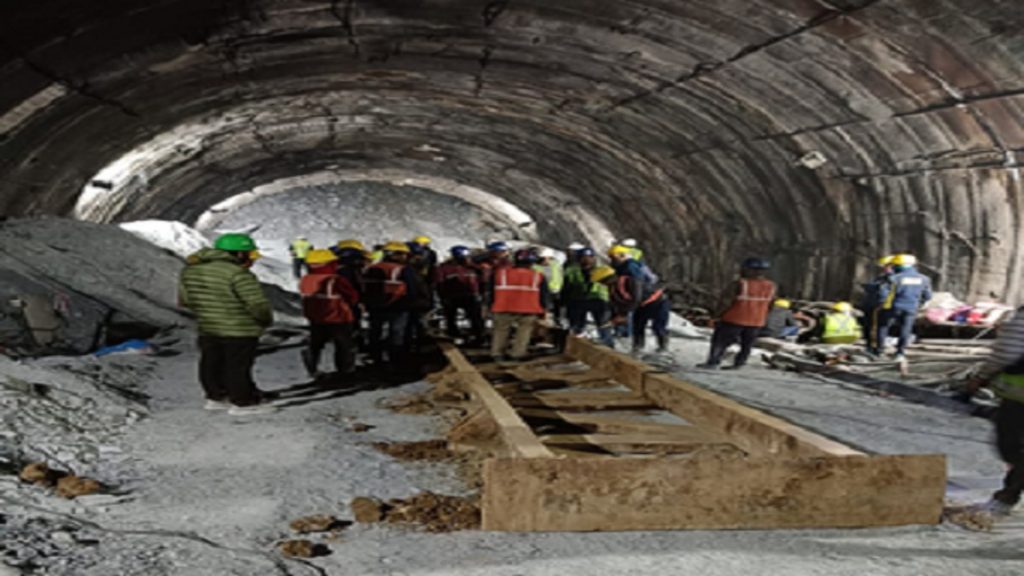Uttarkashi: Manual drilling will start soon to cut through the debris that separates rescuers from the 41 trapped workers in the collapsed portion of the Silkyara tunnel in Uttarkashi, officials informed on Saturday.
According to officials, manual drillers will get to work once the US-made, heavy-duty Auger drilling machine is removed from the pipeline through which the trapped workers are to be brought out.
#WATCH | | Uttarkashi (Uttarakhand) tunnel rescue: NDRF demonstrates the movement of wheeled stretchers through the pipeline, for the rescue of 41 workers trapped inside the Silkyara Tunnel once the horizontal pipe reaches the other side. pic.twitter.com/mQcvtmYjnk
— ANI (@ANI) November 24, 2023
Manual drillers will work to cut through the remaining rubble that separates the rescuers from the workers and enable the insertion of the pipeline through the further few metres that are yet to be covered.
The ongoing operation to rescue workers, who were trapped after a portion of the tunnel collapsed on November 12, entered its 14th day on Saturday.
#WATCH | Uttarkashi (Uttarakhand) Tunnel Rescue | Inside visuals of the tunnel as the rescue operation continues.
(Video Source: Working Staff) pic.twitter.com/11qIXiJNeX
— ANI (@ANI) November 20, 2023
Success could soon be achieved in taking the Auger driller out of the pipeline, officials informed further, adding that the heavy-duty drillers could now be moved back by 22 metres.
Speaking to ANI, a senior official involved with the rescue operation said manual drilling could start soon.
He added that the remaining debris, extending approximately up to 6 to 9 metres, which stands between the rescuers and the trapped workers, will be removed through manual drilling.
#WATCH | Uttarkashi (Uttarakhand) tunnel rescue | IG Garhwal Range, KS Nagnyal says, “We have made all the arrangements for ambulances…We’ll take them (trapped workers) from the site to the hospital through green corridor. As per the doctor’s advice, we can also airlift people… pic.twitter.com/DVgkEAvX3V
— ANI (@ANI) November 23, 2023
Elaborating on the reasons why the officials involved in the rescue operation have decided to remove the Auger from the pipeline, the senior official told ANI, “While drilling with the US-made Auger machine, if we hit an obstruction every two to three feet, we have to remove it. And, every time we hit an obstruction, we have to roll Auger back 50 metres (up to which the pipeline has been laid). After running repairs, the machine has to be pushed back up to 50 metres, which takes about 5 to 7 hours. This is the reason why the rescue operation is taking longer than it should.”
“The rescue team has now decided that the pipeline will now be extended further through manual drilling over small distances. Even if we hit an obstruction further up, the issue could be resolved manually and the pipeline could be extended further without losing out on precious time,” the official added.
He informed further that after drilling up to a further 5 metres, the rescuers will reach the final few metres that separate them from the trapped workers.
However, the officials refrained from quoting a timeframe within which the rescue mission could be completed, saying that they were hopeful of a positive outcome once the manual drilling starts on Saturday.
Earlier, a team of experts, who came to conduct a survey at the tunnel site, informed that there were no heavy objects up to 5 metres inside the tunnel.
The team from Parsan Overseas Pvt Ltd Delhi used the ground-penetrating radar (GPR) technique to examine the rescue tunnel.
Ground Penetrating Radar, also known as GPR, Georadar, Subsurface Interface Radar, or Geo-probing Radar, is a totally non-destructive technique to produce a cross-section profile of the subsurface without any drilling, trenching or ground disturbances.GPR profiles are used for evaluating the location and depth of buried objects and to investigate the presence and continuity of natural subsurface conditions and features.
After examining the rescue tunnel, geophysicist and GPR survey team member B Chendhoor said they were called to the scene after the Auger driller hit an obstruction.
After a portion of the tunnel caved in on November 12, the debris falling in the 60-metre stretch on the Silkyara side of the tunnel trapped 41 labourers inside.
The workers are trapped in a 2 km-built portion, which is complete, including concrete work, which provides them safety.

